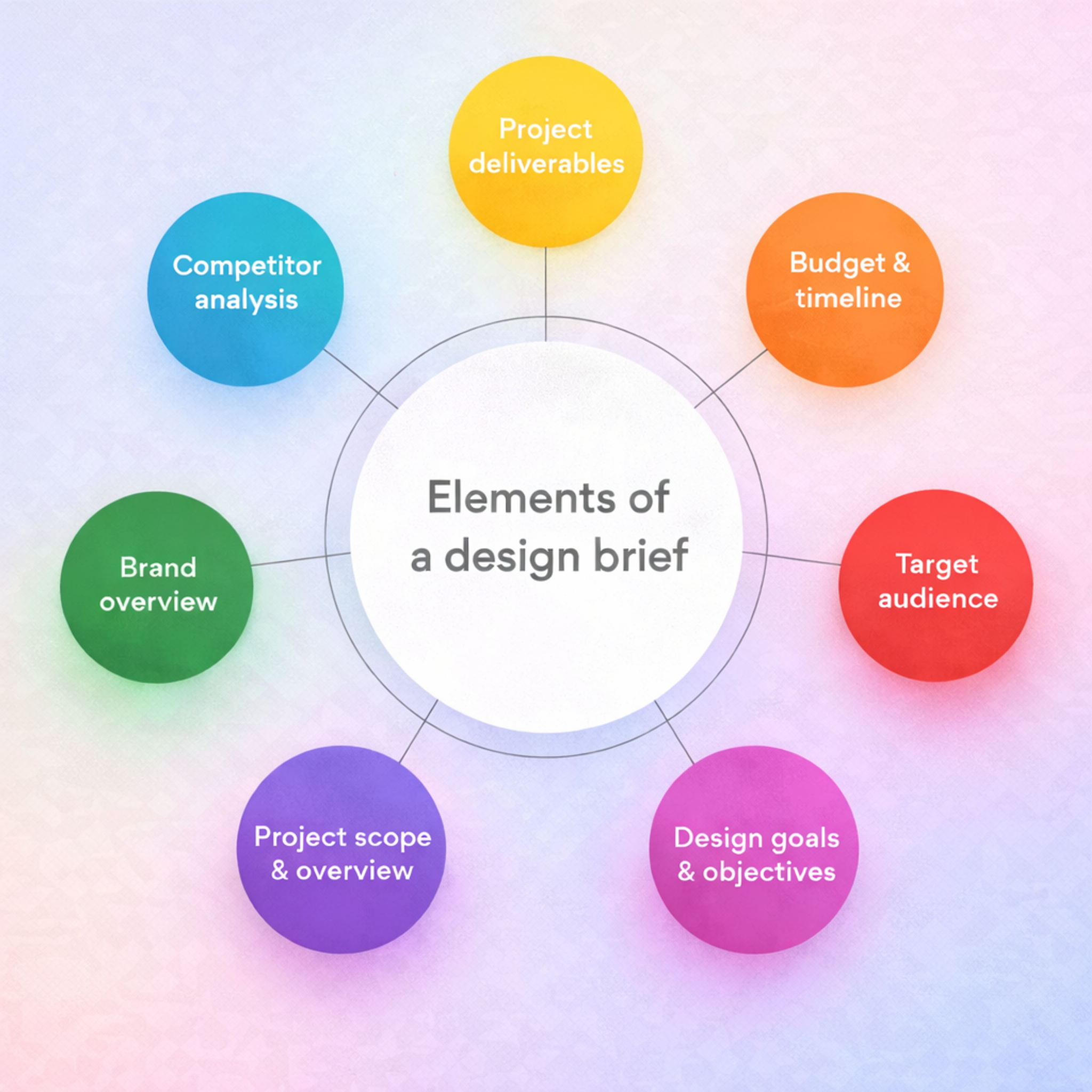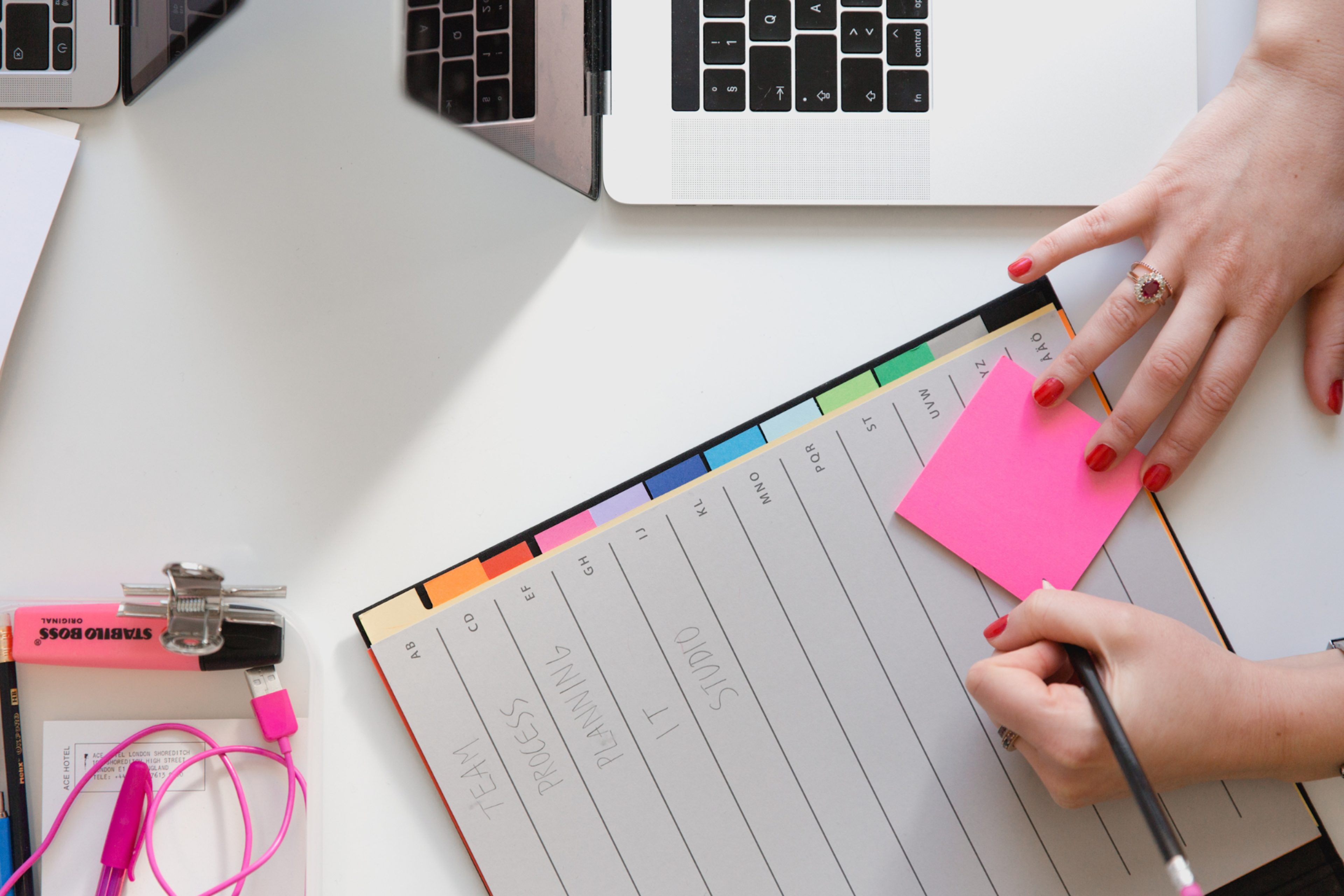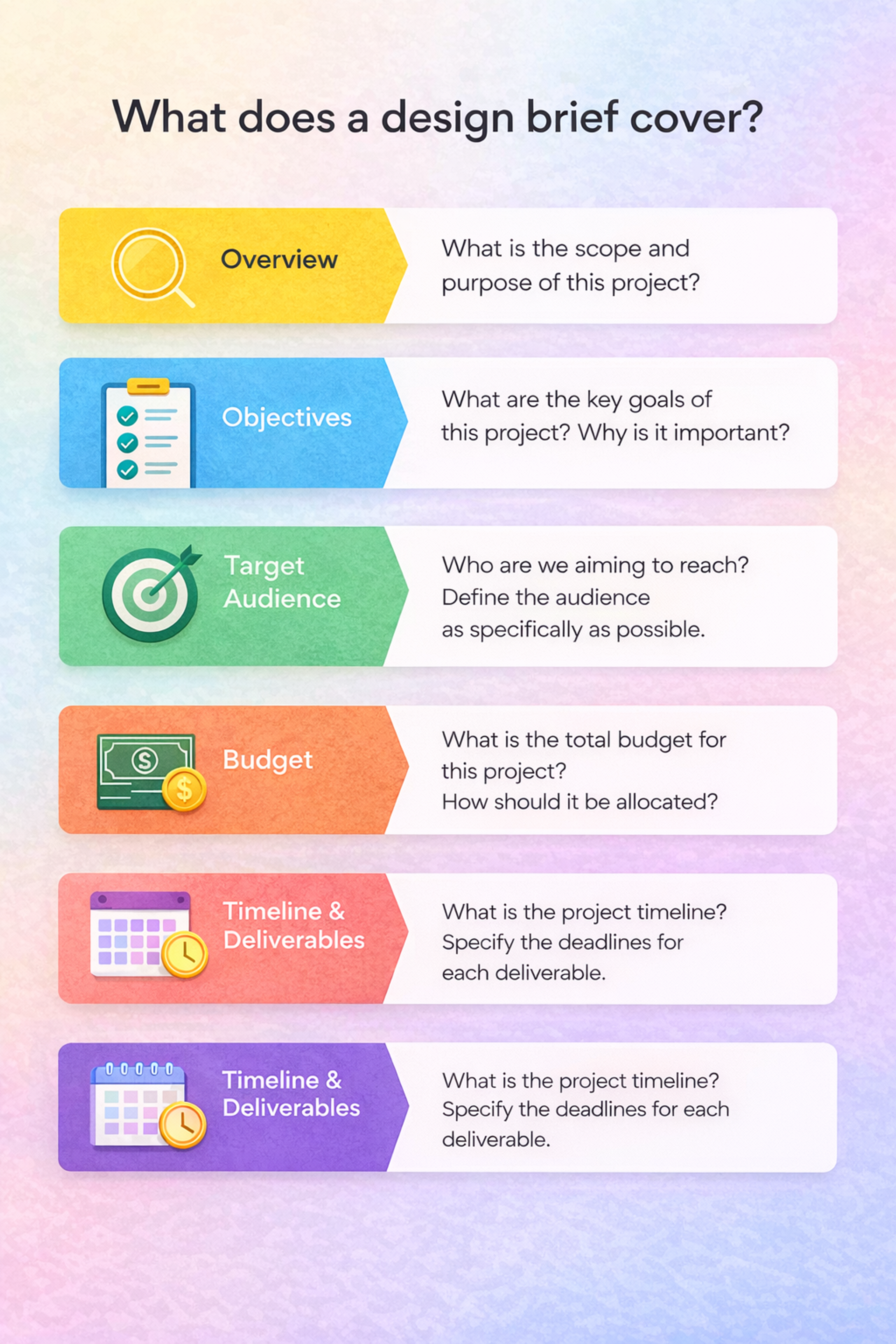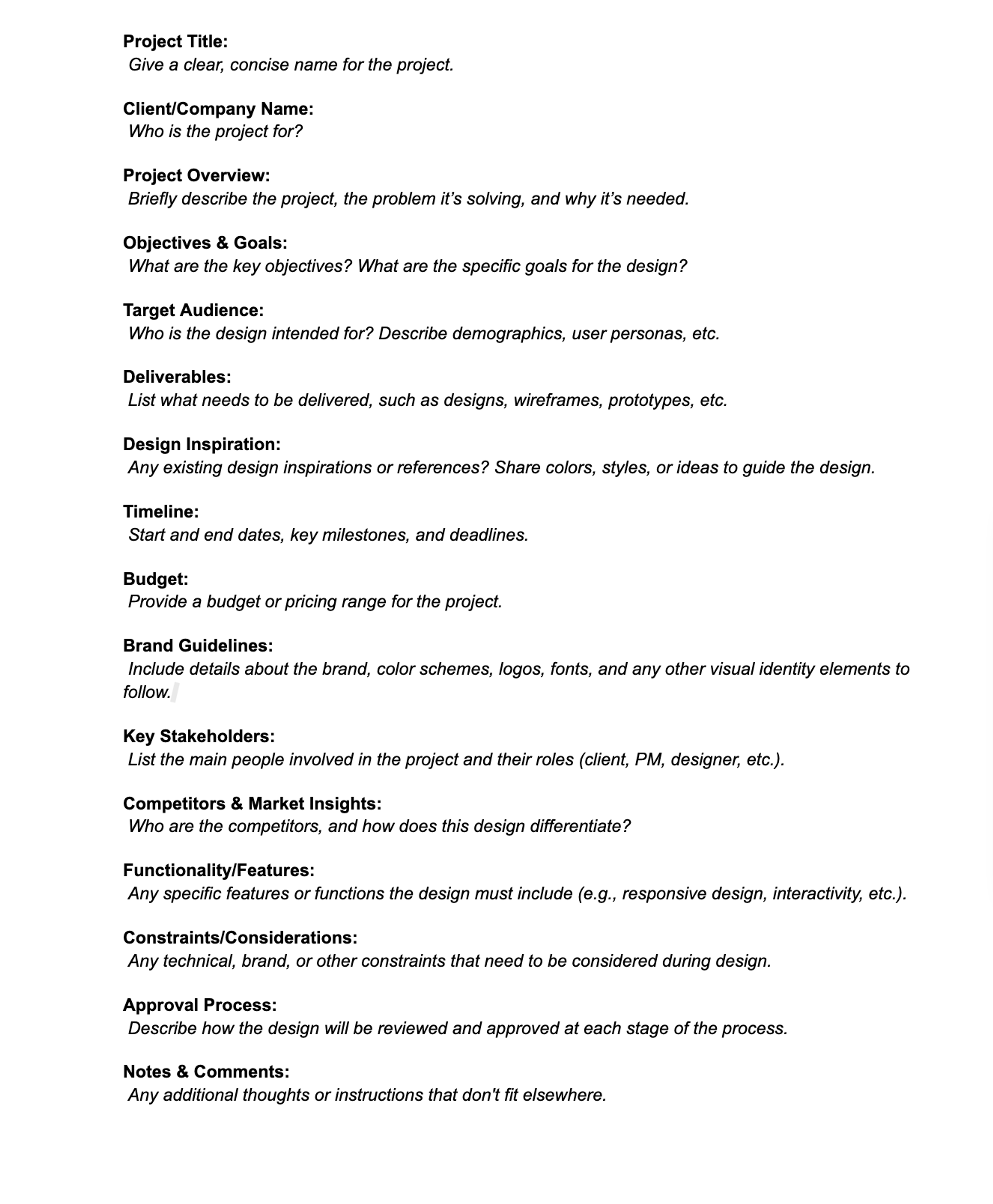You've probably heard the term 'design brief' thrown out several times, but you may need clarification on what that even means. If you plan to work with a designer on any content, especially web design, you must create one. It's a blueprint and a handful of supporting documentation and information to guide the design process. It has even been said that "Designing without a design brief is like playing charades."
What Is a Design Brief?
A design brief is a document created by a client or employer and given to a designer outlining the requirements for a design project. It usually includes information about the project's background, purpose, goals and objectives, target audience, and timeline.
The brief serves as an agreement between both parties and should be clear and concise to ensure everyone understands what is expected of them.
A well-written design brief helps ensure the project runs smoothly, saves time, and produces successful results. Providing detailed instructions in advance of the project's beginning and design thinking process allows designers to get started quickly with minimal confusion or misinterpretation.
Elements of a Design Brief

Difference Between a Design Brief and a Creative Brief
Though both documents are necessary in a design process, a design brief and a creative brief serve different functions. A creative brief focuses on the high-level aspects of the strategy and vision of a project, while a design brief digs deeper into the specific objectives and requirements of the design. A design brief works in conjunction with a creative brief. More detailed road map for the design team.
The Importance of a Design Brief: Why You Need a Design Brief
Any design project that aims for success must include a design brief. A design brief is the foundation of a project's success, and its objectives and goals are a determined set of expectations along with any constraints that may be present.
The project should address the objectives first. The expectations must be reasonable, aided by a logical process of understanding the objectives. Design briefs foster collaboration between different stakeholders.
As a result, the design brief assists in setting and organizing different aspects of the design project, which is necessary to ensure that the project remains under budget and is completed on time.
Benefits of a Strong Design Brief
A strong design brief offers numerous benefits, including:
- Ensures clear communication and understanding among stakeholders
- Provides a clear direction for the design team
- Helps to manage expectations and scope creep
- Enables the design team to create a final design that meets the client’s needs and expectations
- Saves time and resources by avoiding misunderstandings and miscommunication
- Enhances collaboration and teamwork among stakeholders
Who Should Create a Design Brief?
A design brief is crucial for any design project. It acts as a guide for a design team and minimizes contradictions related to goals. It also helps focus on timelines and the budget, among other crucial factors. A brief must be written by someone who understands the purpose clearly.
Source: Marten Bjork on Unsplash

This person understands the design cycle and the client or company goals well. It includes designers and people in marketing or product teams, as they deeply understand the audience they are trying to design for.
In other words, stakeholders from different departments of a company should also be included in the design brief to cover all the angles.
How Do You Write Design Briefs?
5 Key Things to Include in a Design Brief
A design brief should include a clear description of the design project, its goal and objectives, the target audience and their needs and preferences, a timeline, an indication of the budget, and any special considerations.
The design brief should also include examples of similar work done in the past and any specific requirements from the client, such as required fonts or color palettes.
A good design brief will provide the design team with all the information they need to create a successful design that meets all the criteria set out in the brief.
Additionally, a designer must be able to communicate effectively with their client, so a detailed but concise brief outlining the project expectations can help ensure both parties are on the same page throughout the process.
Elements that Design Brief covers

Step 1: Determine the Goals and Objectives of the Design
Of course, a design with a clear goal or objective has more merit. It's essential to state the design goal and what you hope the design work will accomplish. This way, the designer or web design agency will know what role this design fills in the grand scheme.
For example, you might need a new website design to portray a new brand image. Getting a new design is probably a good idea if you've got a new logo, slogans, or color palette. Ensure you're clear with your designer on the project's purpose.
Step 2: Communicate the Project Budget and Timeline Requirements
A design brief needs to focus on the time a designer is given to finish the project and the compensation the designer will receive. This is a necessity for all types of work in any industry.
Regardless, a designer needs to know all these details to decide whether to engage with the project or focus on other projects.
Assigning a dollar amount to each deliverable within the design brief can mitigate a difference between a designer's perception of the price quote and the dollar value the client offers. If clearly outlined, these figures can help determine whether a designer is maloptimizing the price quote while a client is underutilizing the value offered.
Source: Kelly Sikkema on Unsplash

Step 3: Include Details About Your Target Audience
This tip may be less evident than the first two, and, likely, you should have realized that this is part of creating a design brief. However, it's not a good idea to wait until the end of the project to bring up that your design will be primarily shown to people over 60 years old.
In this case, you want to offer them something well-balanced between subtlety and clarity. On the other hand, something grand attracts a younger target audience. If you reach people working 40 hours a week, you should have something that can be captured quickly. After all, they may glance away at any moment.
As a designer, your job is to develop practical solutions to problems. You must narrow it down to a specific audience to do this effectively. This is purely because the intended audience will, to a large extent, determine the design approach.
Step 4: Get Clear About the Scope of the Design Project
Source: Towfiqu barbhuiya on Unsplash

A significant value in writing creative briefs is ensuring that the expected output is clearly articulated. This value is enabled through itemized lists, where the deliverables are separated from the associated budget and delivered individually or alongside the budget estimates.
In any format, the deliverables hint in some way at what design choices and parameters the designer or design agency needs to work within for your newly defined project. It would be unfortunate for the designers to spend several hours preparing print files for them only to determine that they required their web designs.
In the same way, it would be problematic to assume you loved the design when, in fact, there are fundamental implementation files that are missing. In either case, these problems can be avoided once both parties clearly understand the inclusion and exclusion in the design brief.
Step 5: Include a 'Big Picture' Idea of how the Ideal Design Would Look
To guarantee that any design you commission comes out beautifully, provide your designers with a strong visual for the design. It is nearly impossible to sketch the design to the necessary detail. If that were the case, a designer would be redundant to you!
You may think of it like a producer humming a melody to cue a recording artist. You have clear resemblances in your mind. The designer knows how to get it out of your head.
Source: Mark Fletcher-Brown on Unsplash

Step 6: Beware of Competition
All businesses have competition, and a competitor in a different location is doing all the work we are doing. A deep understanding of competing brands allows for innovative designs that stand out.
Designers ought to analyze competitors' previous successful design strategies, and the opposite, to make better decisions for the following creative brief. Deep knowledge of the client's competitors allows the designer to make more effective decisions.
Understanding Your Brand and Audience
Brand Overview and Brand Guidelines
A brand overview is a critical component of a design brief, providing essential information about the client’s brand, including its mission, values, and unique selling points. Brand guidelines, on the other hand, outline the specific design elements that are unique to the brand, such as logos, color palettes, typography, and imagery. By including a brand overview and brand guidelines in the design brief, the design team can ensure that the final design is consistent with the client’s brand identity and messaging.
A brand overview should include:
- A concise background on the brand and company mission
- Information about the brand’s target audience and their needs
- Details about the brand’s unique selling points and competitive advantage
- Information about the brand’s tone of voice and personality
Brand guidelines should include:
- A dedicated brand style guide that outlines the dos and don’ts for upcoming projects
- Information about the brand’s logos, including usage guidelines and minimum size requirements
- Details about the brand’s color palette, including hex codes and Pantone colors
- Information about the brand’s typography, including font families and font sizes
- Guidelines for imagery and photography, including style and tone
Some Design Brief Template
A Simple Design Brief Template
Design Brief Template

If you need help with how to start creating your brief, look at design brief examples or start with a good design brief template. This helps you get from knowing you need a brief to take action on creating one!
Design Brief Examples
A well-crafted design brief serves as a roadmap, ensuring that both the client and the designer are aligned on the project's goals, scope, and expectations. Here are a couple of examples:
1. E-Commerce Website Redesign
Objective: Revamp the existing online store to enhance user experience, increase conversion rates, and ensure mobile responsiveness.
Scope:
- Current Challenges: High bounce rates on product pages and a complicated checkout process.
- Deliverables: Redesigned homepage, product pages, and a streamlined checkout process.
Target Audience: Tech-savvy individuals aged 18-35 who prefer shopping online.
Budget: €15,000
Timeline: 3 months
2. Non-Profit Organization Logo Design
Objective: Create a modern and memorable logo that reflects the organization's mission to support environmental conservation.
Scope:
- Design Requirements: Incorporate elements of nature, use earthy tones, and ensure scalability for various mediums.
- Deliverables: Primary logo, monochrome version, and favicon.
Target Audience: Individuals passionate about environmental issues, aged 25-50.
Budget: €2,500
Timeline: 6 weeks
These examples demonstrate how design briefs can vary in detail and focus, depending on the project's nature and objectives. Crafting a clear and concise design brief is crucial for the success of any design endeavor.
FAQ
What Is The Meaning Of Design Brief?
A design brief is a document outlining a project’s goals, audience, scope, and deliverables that guides designers throughout the process.
How To Write A Design Brief Grade 7?
Explain what you’re designing, who it’s for, what problem it solves, and key requirements. Keep it clear, short, and focused on purpose.
What Is A Design Brief GCSE?
In GCSE Design & Technology, a design brief describes the problem, target user, and success criteria for a project you’ll plan and prototype.
Who Creates A Design Brief?
A client, teacher, or project manager usually writes the brief, but designers can refine it through research and discussion before work begins.
Read more
Conclusion
As a primary means of communication between clients and designers, a design brief clarifies the objectives and desired approach to a project. It eliminates any ambiguity and focuses the attention of all relevant players on the project's primary objectives.
The values of a design project are achieved when the design brief and the project's desired outcome are in alignment. This is achieved by fulfilling the design brief's requirements of specifying the audience, goals, objectives, relevant resources to be utilized, and the other critical elements that come into play. All in all, design briefs serve for structural clarity that will ensure all design goals are met.


About Clay
Clay is a UI/UX design & branding agency in San Francisco. We team up with startups and leading brands to create transformative digital experience. Clients: Facebook, Slack, Google, Amazon, Credit Karma, Zenefits, etc.
Learn more

About Clay
Clay is a UI/UX design & branding agency in San Francisco. We team up with startups and leading brands to create transformative digital experience. Clients: Facebook, Slack, Google, Amazon, Credit Karma, Zenefits, etc.
Learn more


